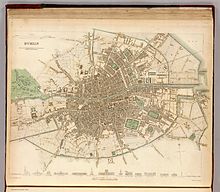1899 Dublin Corporation election
This article relies largely or entirely on a single source. (October 2014) |
| |||||||||||||||||||||||
All 60 seats to Dublin Corporation 31 seats needed for a majority | |||||||||||||||||||||||
|---|---|---|---|---|---|---|---|---|---|---|---|---|---|---|---|---|---|---|---|---|---|---|---|
| |||||||||||||||||||||||
 Map showing results by ward. | |||||||||||||||||||||||
| |||||||||||||||||||||||
An election to Dublin Corporation took place in March 1899 as part of that year's Irish local elections.
Background[]
The election, being the first following the 1898 changes to Irish local government, saw substantive changes to the franchise. Prior to these changes the franchise had been restricted to males over the age of 21 who had maintained a continual residence within the borough for the preceding 2 years and 8 months, thereby preventing Dublin's large lodger and floating tenement population from voting.[1] As a result of the changes the franchise increased from 7,964 in the previous elections to 38,719. Among these voters were 6,500 women who could vote for the first time.[2]
Contest[]
The 60 seats for election were contested by 120 candidates; 18 Unionists, 10 Labourites, 88 Nationalists, and 1 representative of the Irish Socialist Republican Party.[3]
This was the first time representatives of organised Labour participated in their own right, fighting under the banner of the Labour Electoral Association. Previously the Labour interest had been represented by Nationalist "Labour" spokespersons. That being said, the party only contested 10 of Dublins 60 seats, meaning the party did not even put forward 1 candidate per ward.[3]
Results[]
The election saw the Redmonites, who had previously dominated the council, substantially reduced. The Redmonites had previously held 44 of the 60 seats in the old council.[2] Following the election the Redmonites held only 18. United Irish League representation increased substantially to 27. Labour representation increased from 3 to 8, whilst Unionist representation declined to 7.[4]
Results by party[]
| Party | Seats | ± | Votes | % | ±% | |
|---|---|---|---|---|---|---|
| UIL | 27 | |||||
| Irish National League | 18 | |||||
| LEA | 8 | |||||
| Irish Unionist | 7 | |||||
| Totals | 60 | 100% | — | |||
Results by ward[]
Fitzwilliam Ward[]
| Party | Candidate | Votes | % | ±% | |
|---|---|---|---|---|---|
| Irish Unionist | William Ireland J.P. (elected Alderman, incumbent councillor) | 718 | |||
| Irish Unionist | Thomas Anthony Joynt | 676 | |||
| Irish Unionist | Thomas D. Pile (incumbent councillor) | 653 | |||
| Independent Nationalist | Patrick W. Corrigan | 622 | |||
| Joseph Delahunt | 558 | ||||
| Joseph Hatch (incumbent councillor) | 540 | ||||
| Thomas Kennedy (incumbent councillor) | 520 | ||||
| Philip Redmond | 344 | ||||
| William Cashen | 320 | ||||
| James Brooks | 297 | ||||
| Majority | |||||
| Turnout | 1,805 | ||||
| gain from | Swing | ||||
Post-election boundary extensions[]

At the time of the election Dublin council at the time was composed of 60 members, and was still restricted in area to its historic boundaries, contained to the south by the Grand Canal. This was despite the fact that proposals for extending the municipal borough had existed since the 1880s, in part to deal with the issue whereby residents of the Dublin suburbs had access to and benefited from city services, but were not subject to Dublin municipal taxation. By 1899 Dublin was the only major city in the United Kingdom which had not seen an expansion of its municipal boundaries.[8]
A private members bill was raised in parliament, proposing to extend Dublins municipal boundaries to include several neighboring townships, and was fiercely opposed by Irish Unionists, although the incumbent Conservative government took a neutral position. The majority of councillors for the townships, who were also Unionists, opposed the plan, and several petitions opposed to the plan were submitted to parliament. Ultimately a deal was made whereby New Kilmainham, Drumcondra, Clonliffe, Glasnevin, and some county land was added to the borough, although the more populous southern townships of Pembroke and Rathmines were not.[8]
This resulted in the creation of some 5 extra wards, and the total number of councillors was increased to 80.[9] Twenty new members were thus elected in January 1901, of whom 9 were Unionists, thereby bringing Unionist representation up to 16. This meant that by January 1901 Unionists were returned to the 20% representation they enjoyed prior to 1899.[10]
References[]
Sources[]
- O'Brien, Joseph Valentine (1982). Dear, Dirty Dublin: A City in Distress, 1899–1916. University of California Press. ISBN 9780520039650. Retrieved 18 September 2018.
Citations[]
- ^ O'Brien 1982 p.72
- ^ a b "First Irish Voting Under New System". Auckland Star. Vol. XXX, no. 60. 13 March 1899. p. 2. Retrieved 18 September 2018.
- ^ a b O'Brien 1982 p.78
- ^ O'Brien 1982 pp.285–294
- ^ List of Unionist candidates
- ^ Results
- ^ Freeman's Journal - Wednesday 15 January 1902, p.6
- ^ a b O'Brien 1982 pp.82–83
- ^ O'Brien 1982 p.80
- ^ O'Brien 1982 p.83
- 1899 Irish local elections
- Dublin City Council elections